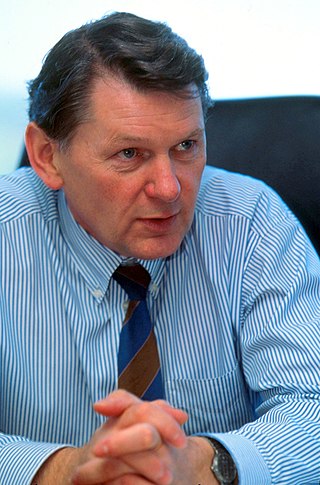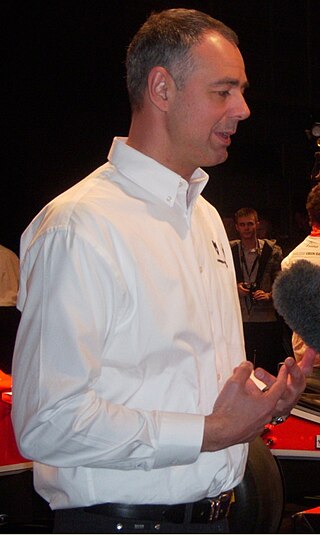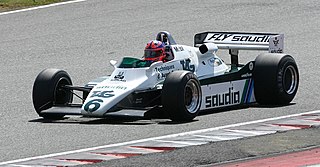Related Research Articles
Sir Patrick Michael Head, FREng is a British motorsport executive who is the co-founder and former Engineering Director of the Williams Formula One team. For 27 years starting from the 1977 season, Head was technical director at Williams Grand Prix Engineering, and responsible for many innovations within Formula One. Head oversaw the design and construction of Williams cars until May 2004 when his role was handed over to Sam Michael.

Ross James Brawn is a British Formula One managing director, motor sports and technical director. He is a former motorsport engineer and Formula One team principal, and has worked for a number of Formula One teams. Teams with Brawn in an essential role have won eight constructors' championships and eight drivers' championships in total. Serving as the technical director of the championship-winning Benetton and Ferrari teams, he earned fame as the "mastermind" behind Michael Schumacher's seven world championship titles. He took a sabbatical in 2007 and returned to F1 for the 2008 season as team principal of Honda.

John Edward Barnard, is an English engineer and racing car designer. Barnard is credited with the introduction of two new designs into Formula One: the carbon fibre composite chassis first seen in 1981 with McLaren, and the semi-automatic gearbox which he introduced with Ferrari in 1989.
Arrows Grand Prix International was a British Formula One team active from 1978 to 2002. It was known as Footwork from 1991 to 1996.

Larrousse Formula One was a motorsports racing team founded in 1987 by Didier Calmels and former racer Gérard Larrousse, originally under the name Larrousse & Calmels. It was based in Antony, in the southern suburbs of Paris. It was renamed Larrousse after the departure of Calmels following his murder of his wife. The team competed in Formula One from 1987 to 1994 before succumbing to financial problems, scoring a best finish of third at the 1990 Japanese Grand Prix during this time.
Pacific Racing was a motor racing team from the United Kingdom. Following success in lower formulae, the team took part in two full seasons of Formula One, in 1994 and 1995, entering 33 Grands Prix without any success.

Nicholas John Peter Wirth is an automotive engineer and the founder and owner of Wirth Research.

The Williams FW07 was a ground effect Formula One racing car designed by Patrick Head, Frank Dernie, and Neil Oatley for the 1979 F1 season.
Eric Harrison Broadley MBE was a British entrepreneur, engineer, and founder and chief designer of Lola Cars, the motor racing manufacturer and engineering company. He was arguably one of the most influential automobile designers of the post-war period, and over the years Lola was involved with many high-profile projects in Formula One, IndyCar, and sports car racing. Broadley sold Lola to Martin Birrane in 1997.
Sergio Rinland is an Argentine engineer best known for his work in Formula One. He is currently owner and managing director of the automotive engineering and management consulting company Astauto Ltd.

André de Cortanze is a French motorsport engineer.

Pat Fry is a British motorsports engineer. Primarily working in Formula One, he has previously held positions with the Benetton, McLaren, Ferrari, Manor Racing, and Renault/Apline teams. As of 2023, Fry is the chief technical officer for Williams Grand Prix Engineering.

Jock Clear is an English senior performance engineer working for Scuderia Ferrari, where he is currently the driver coach for Charles Leclerc, alongside Calum MacDonald for Carlos Sainz Jr. Before moving to Ferrari, he worked at Mercedes, where he was the performance engineer for Lewis Hamilton (2013–14) and Michael Schumacher (2011–12). He was also the race engineer for Nico Rosberg (2010–2011), Rubens Barrichello (2006–2009), Takuma Sato (2003–2005), Jacques Villeneuve (1996–2003), David Coulthard (1995) and Johnny Herbert (1994).

Équipe Ligier is a motorsport team, best known for its Formula One team that operated from 1976 to 1996. The team was founded in 1968 by former French rugby union player Guy Ligier as a sports car manufacturer.

The DAMS GD-01 was an unraced Formula One car used by the French motorsport team, Driot-Arnoux Motor Sport (DAMS). The GD-01 was designed and built by a collaboration of DAMS and Reynard engineers from 1994 to 1995, and was intended to establish the team—which had achieved considerable success in lower categories—in Formula One (F1), the premier Fédération Internationale de l'Automobile (FIA)-sanctioned level of racing. However, due to insufficient financial backing, the team never entered the championship, despite completing construction of the chassis and conducting limited testing.

Prost Grand Prix was a Formula One racing team owned and managed by four-time Formula One world champion Alain Prost. The team participated in five seasons from 1997 to 2001.

The Dome F105 was an unraced Formula One car designed and built by the Japanese motorsport constructor, Dome.

The Williams FW08 was a Formula One car designed by Frank Dernie, which debuted at the 1982 Belgian Grand Prix held at the Zolder circuit. An evolution of the FW07 that it replaced, the car was used by Finnish driver Keke Rosberg to win the 1982 World Drivers' Championship.

Reynard Motorsport was the world's largest racing car manufacturer in the 1980s. Initially based at Bicester and latterly at Reynard Park, Brackley, England the company built successful cars in Formula Ford 1600, Formula Ford 2000, Formula Vauxhall Lotus, Formula Three, Formula 3000 and CART.
Ian Randell Pocock is a British engineer.
References
- ↑ "Engineering changes at Benetton". grandprix.com. 6 February 1995. Retrieved 10 March 2007.
- ↑ "Dernie joins Toyota". grandprix.com. 29 August 2007. Retrieved 30 August 2007.
